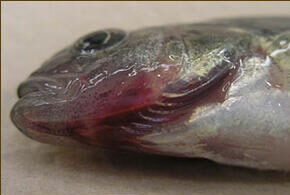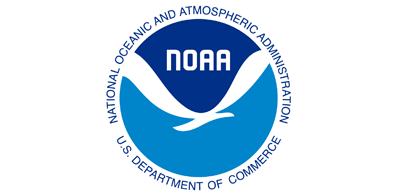PDF coming soon

Viral Hemorrhagic Septicemia (VHS)
Novirhabdovirus
Species at a Glance
Viral Hemorrhagic Septicemia (VHS) virus is a highly contagious fish pathogen that is known for causing significant fish kills in the Great Lakes region of the United States and Canada. In Pennsylvania, regulations are in place to prevent its spread through infected fish or contaminated water.
Species Description
The VHS virus is a highly contagious bullet-shaped virus of the genus Novirhabdovirus. VHS strains vary in their severity; for example, in Rainbow Trout, the European freshwater strains can cause severe mortalities, while North American or northern European marine strains cause little or no symptoms.
Native & Introduced Ranges
Outbreaks in the Great Lakes appear to be a mutated strain of the marine virus that has become pathogenic for freshwater fish. Although it is unclear exactly when and how the virus was transferred into the Great Lakes, scientists think it was introduced into the region as early as 2003, and related fish mortality has been reported since 2005. The virus could have arrived in the Great Lakes in the ballast water of ocean-going ships, through aquarium and live fish releases, fish stocking, or from the ocean by migrating fish. In North America, VHS is present in the waters of lakes Erie, Huron, Michigan, Ontario, and St. Clair, as well as the Detroit, Niagara, and St. Lawrence Rivers.
Biology & Spread
VHS is a highly contagious disease that is easily transmissible to fishes of all ages and many different species. Survivors of the infection can become lifelong carriers of the disease. Virus transmission can occur through contact with the water or diseased fish, predation on infected fish, or shed with urine and reproductive fluids. It can enter the body through the gills or open wounds. Transfer to new water bodies is thought to be primarily through fish stockings, baitfish transfer, and by moving live contaminated fish from one water body to another. Other possibilities are through recreational angler and boating activities. The intestinal tract of warm-blooded mammals inactivates the virus, and it does not replicate in insects; therefore, waterfowl, insects, and parasites are not likely vectors.
Habitat
Fish mortality from the VHS infection is highest at low water temperatures between 48 and 54°F (9-12°C). Deaths from VHS rarely occur at temperatures above 59°F (15°C). Outbreaks often occur during stressful environmental changes, for example in the spring when the water temperature is rising, or during spawning. The disease can occur at any age, but younger fish appear to be more susceptible to it.
Impacts
Threat to Biodiversity
At least 50 species of marine and freshwater fish carry the virus, including Muskellunge, Smallmouth Bass, Northern Pike, Freshwater Drum, Gizzard Shad, Yellow Perch, Black Crappie, Bluegill, Rock Bass, White Bass, Redhorse Sucker, Bluntnose Minnow, Emerald Shiner, Round Goby, and Walleye. While there are no specific visual signs of VHS, symptoms of the disease may include bulging eyes, bloated abdomens, darker coloration, inactive or overactive behavior, and hemorrhaging in the eyes, muscle tissue, skin, gills, and at the base of the fins. Testing is necessary to confirm that a fish is infected with VHS. Bluntnose Minnows and Emerald Shiners often show no obvious symptoms.
Human Health
There is no indication that VHS is a threat to human health because it cannot replicate in warm-blooded animals; however, hand washing is always a good practice when handling fish and wildlife that show disease symptoms of any kind.
Economic Costs
The Great Lakes fishery represents an estimated 5-billion-dollar annual industry. It is unclear what the long-term risks of VHS will be on this fishery and inland fish stocks; however, observers have already reported large fish kills of certain species. In addition, aquaculture facilities will incur additional testing expenses to ensure their fish are disease free and meet federal and state shipping regulations.
Prevention & Control
The Pennsylvania Fish and Boat Commission has issued the following regulations to prevent the spread of VHS in Pennsylvania (58 Pa. Code § 71a.7 and § 63.51):
- It is illegal to move VHS-susceptible fish from the Lake Erie watershed to other watersheds in Pennsylvania without approval. Bringing VHS-susceptible fish into Pennsylvania from VHS-affected states or regions is also prohibited, unless they are certified VHS free with proper paperwork, are securely transported through Pennsylvania with documentation, are for scientific purposes with permits, or are headed to a processing plant, restaurant, or slaughter facility with documentation.
- It is illegal to sell VHS-susceptible fish from the Lake Erie watershed into other Pennsylvania watersheds without proper approval. VHS-susceptible fish cannot be sold in Pennsylvania from VHS-affected states (IL, IN, MI, MN, NY, OH, WI) or regions (Ontario, Quebec) unless they are certified VHS-free, and proper paperwork is provided.
In addition, recreational water users can help prevent the spread of VHS and other aquatic invasive species by taking the following steps:
- Always check for and remove plants, mud, and debris from boats, trailers, clothing, and equipment before entering a water body and before leaving a water body.
- Drain all water from bait buckets, bilges, and live wells before transporting to new areas.
- Clean all gear and equipment with hot water (140°F or 40°C) or salt water, OR let boats and equipment dry thoroughly for at least five days before entering a new water body.
- Unused live bait should be disposed of in the trash; it is unlawful in Pennsylvania to release any unused live bait.
- When cleaning fish, make sure that waste products do not come into contact with other waterways, and dispose of fish internal organs, skin, scales, heads, and tails in the garbage.
References:
- Pennsylvania Fish and Boat Commission, VHS regulations, 58 Pa. Code §71a.7 and §63.51 (2024)
- The Center of Food Security and Public Health and the Institute for International Cooperation in Animal Biology. 2007. Viral Hemorrhagic Septicemia. Briefing Paper
- Whelan, G. E. 2007. Viral Hemorrhagic Septicemia (VHS) Briefing Paper. Michigan DNR.



